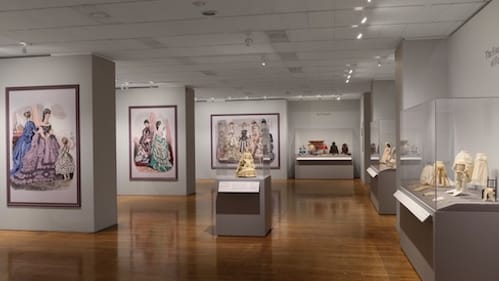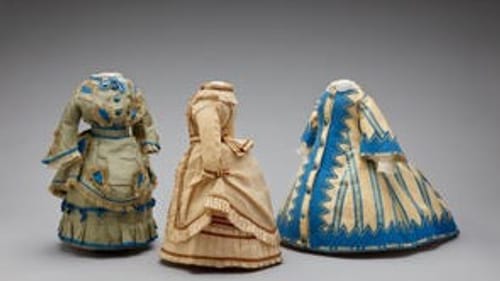Stay in the Loop
BSR publishes on a weekly schedule, with an email newsletter every Wednesday and Thursday morning. There’s no paywall, and subscribing is always free.
"The germ of womanhood"
Philadelphia Museum of Art’s 'Little Ladies: Victorian Fashion Dolls and the Feminine Ideal'

The Philadelphia Museum of Art’s Little Ladies: Victorian Fashion Dolls and the Feminine Ideal is a visual delight and an unblinking commentary on the inculcation of gender roles through play. The new exhibit makes a thoughtful companion to Fabulous Fashion: From Dior’s New Look to Now, which was also organized by Kristina Haugland, LeVine associate curator of costumes and textiles.
The “ladies” are fashion dolls, vintage 1860 to 1870: Miss Marie Antoinette, Miss G. Townsend, Miss French Mary, Miss Mary Scott, and Miss Fanchon. Their heads are bisque, their eyes are glass, and their bodies are sawdust-filled kidskin.
But it’s their accouterments that grab attention. They have monogrammed sheets and stationery, delicate lingerie and fur-trimmed capes, sparkling tiaras and vials of perfume — opulence enough to make even a certain Malibu Dream House resident envious.
Playthings with a purpose
The dolls, about 18 inches tall, would have been presented to daughters of the well-to-do, not only to amuse but to introduce girls to the well-dressed, perfectly proper wives and mothers they were expected to become. Victorian daughters weren’t told “Oh, the places you’ll go” as much as “Oh, the man you’ll marry and the things you’ll own!”
Accessorized with a wardrobe for every occasion, from receiving guests to attending the opera and marrying to mourning, the dolls encouraged little girls to inhabit their future lives.
A blue-and-white-striped walking dress is particularly noteworthy for its billowing train, extending from shoulder to ground. It’s a sail of fabric that resembles a parade float moving at full speed. This ensemble would make a marathon of the shortest stroll — assuming, of course, the wearer could get out of the house. A display of undergarments reveals items of such variety and complexity that it’s hard to imagine Victorian women dressing once a day, much less changing outfits to suit the activity.
The doll clothing and accessories are exquisitely made and all the more impressive for their scale. Clasps are the size of a grain of rice, and stitching is incomprehensibly fine. Silks are gathered into neat pleats and swags the size of rose petals. Outfits are trimmed in lace, fringe, and rabbit fur and complemented with leather boots, gloves, purses, fans, and all manner of hats.

Social commandments, Gilded Age commandments
Aside from being physically molded by corsets, hoop skirts, and horsehair bustles, women of the period were groomed mentally. Socially preferred instructions for every situation could be internalized from publications such as Mrs. M.L. Rayne’s 1880 Gems of Deportment and Hints of Etiquette, one of several period behavioral guides that open the exhibit.
A modern woman’s pulse races just reading the 27 behaviors to be avoided when making a social call in Thomas E. Hill’s 1874 Hill’s Manual of Social and Business Forms: A Guide to Correct Writing. Among them: “Do not fidget with your cane, hat, or parasol… Do not lay aside your bonnet… Do not linger at the dinner-hour… Do not take a dog or small child.” (I momentarily mistook this to mean polite visitors should avoid kidnapping pets and offspring.)
Gallery text illuminates just how important social standing was to Victorians and how much was expected of women in extremely narrow roles. The importance of toys in transmitting cultural expectations is made plain in the 1869 Godey’s Lady’s Book, quoting author Victor Hugo: “The first child is a continuation of the last doll. A little girl without a doll is nearly as unhappy and quite as impossible as a wife without children.”

Further on, near a display of exquisitely tiny dressing accessories, a button hook, bone shoehorn, hairpins, and engraved hand mirror, comes this passage from The Manners That Win (1880): “As it is the duty and pleasure of man to develop his strength, it is equally incumbent on women to cultivate and perfect each germ of beauty.”
Lost lexicon
Besides the artistry of the ladies’ trousseaus and illuminating commentary, the exhibit exhumes long-forgotten details of daily life, such as calling cards and opera glasses, the Twitter and Skype of the day. Lorgnettes, pince-nez, handkerchiefs, and snoods also make appearances, and it’s nice to have those strange words rolling around the mouth.
More sobering, however, are features that are all too recognizable. Women still labor under societal restrictions and, depending on the culture, with much greater difficulty than these upper-class Victorians.
Yet, if you can set aside the exhibition’s darker implications, it’s a pleasure to see the finely made dolls and their belongings and to imagine the simple joy of playing with them. Little Ladies closes on an encouraging note — the girl who played with Miss Mary Scott grew up to become a physician. Thank heaven for little ladies who can’t take a hint.
What, When, Where
Little Ladies: Victorian Fashion Dolls and the Feminine Ideal. Through March 3, 2019, at the Philadelphia Museum of Art, 2600 Benjamin Franklin Parkway, Philadelphia. (215) 763-8100 or philamuseum.org.
Sign up for our newsletter
All of the week's new articles, all in one place. Sign up for the free weekly BSR newsletters, and don't miss a conversation.
